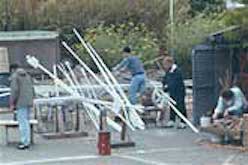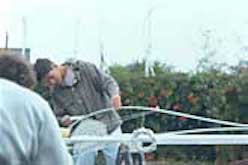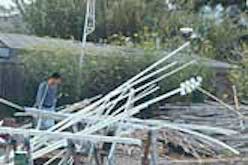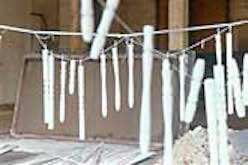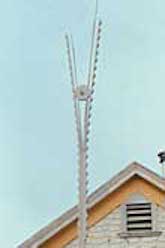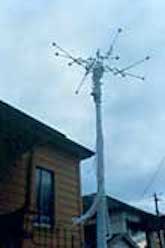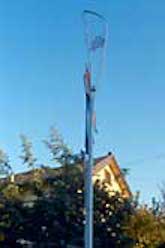1986 – 1991 Vertical Sculptural Poles Project
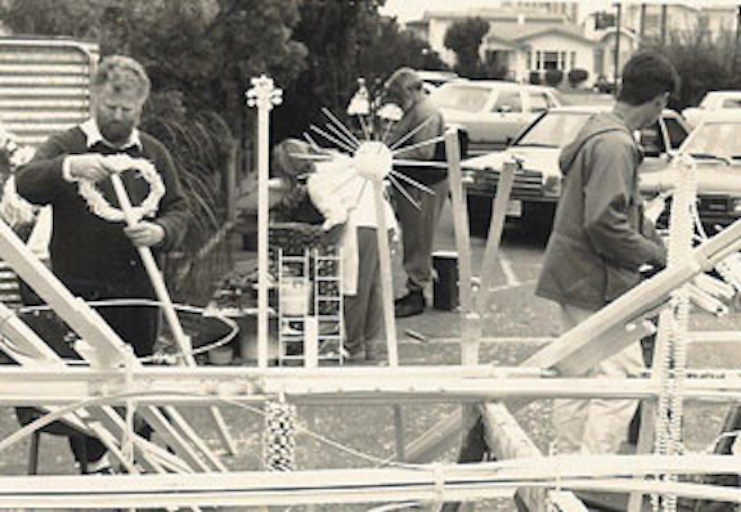
Constructing vertical Sculptures from left Slobodan Dan Paich, Lottie Rose, Oakland artist Arnold White and local volunteer.

This project consisted of great number of semi-permanent sculptures built for and with residents of the Golden Gate neighborhood in North Oakland by Slobodan Dan Paich.
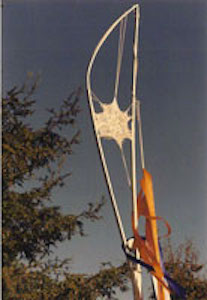
The project was specially conceived for an inner city neighborhood, of low to medium income households interspersed with homes owned by young professionals and some live work spaces, with a rich mixture of African American, white, Asian and Latino populations.
The project started in the garden of a house in the Golden Gate neighborhood that Slobodan was renting. He began constructing a temporary vertical sculpture out of scrap wood. Curious children from the neighborhood came to watch, and soon they were working on the construction with him. Once the first pole sculpture was completed, first one neighboring family asked for a pole installation on their property, and then one other did the same.
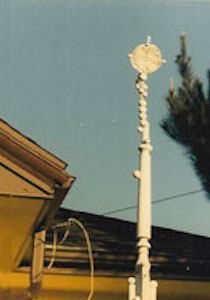
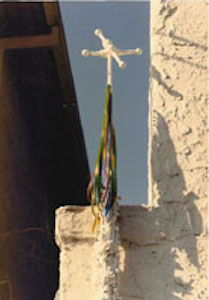


Lottie Rose, Slobodan’s landlady at that time, liked the sculptures and invited Slobodan to make several for her properties in the neighborhood. She offered a shed and outdoor work space in the parking lot of a building she owns on San Pablo Avenue, and that is when the project started in earnest.
Every Saturday for five years Slobodan was involved in constructing the vertical sculptures, assisted by people from the neighborhood, including the future owners of the sculptures. After having sculptures installed on their own properties, some of the neighbors continued to help with installations for other neighboring properties. Quietly, over the five-year life of the project, a great number of people participated.
The sculptures were given to the community free of charge. In addition to providing free space to assemble and stage the work, Lottie Rose donated the paint, brushes, nails, hardware, and even the ribbons. People from the community brought wooden scraps all the time, and later on some local businesses made in-kind donations of materials.
In 1989, the City of Oakland recognized the project with a "Community Promotion Grant" award.
To give project visual continuity and identity it seemed appropriate to continue it in the same vein as the initial sculptures that were installed. Those sculptures were constructed entirely from wooden elements, most of which were recycled materials. The all-white color of the surface was the simplest means of unifying disparate elements and catching the play of light and shadow. The distinctive and colorful elements of the sculptures were the strips of fabric and ribbons flowing out of the sculptural forms.
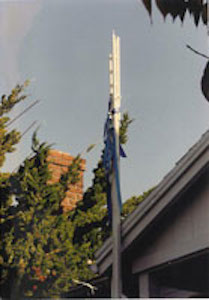
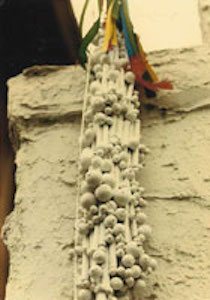


The Sculptural Score
Now in retrospect it can be summarized that the basic forms for the sculptures were an accumulation of divers pieces in to pinnacles of no more than six inches in diameter, and 15 to 16 feet high, that tapered upward into lighter, sometime with an open forms at the top. The sculptures often were accompanied by heavily painted, clogged, crocheted -pieces and other found materials. The forms were punctuated by ribbons complimenting their basic structure.
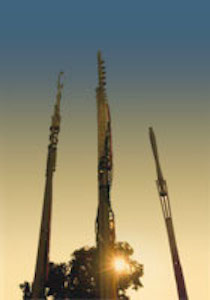
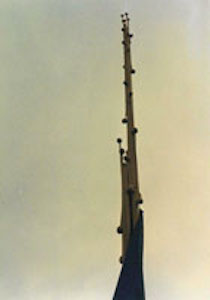
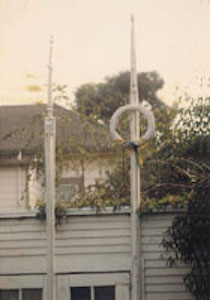


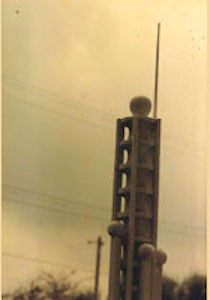
Each time we tried to do something different from this basic score, the sculptural quality and the community of forms were lost. When we tried to paint the sculptures entirely black or brown, they became camouflaged and their immediacy and presence were lost. When we tried to paint just one or a few of the elements, that also broke and diluted the form. When we added larger, more recognizable household elements, they made the sculptures appear cluttered and junky. When we added beautiful, specially embroidered, painted or silk-screened fabrics, they wrapped themselves around the sculptures and smothered them, so that neither the sculptures nor the materials were recognizable. In the end we returned to the basic sculptural score that emerged through the simple acts of people "doing and making" together at the outset of the project.
This process was an interesting dynamic in asking, more than answering, questions:
- What is the artist’s role and what does she or he do in a community setting?
- How do the artistic sensibilities, vision and cohesive visual language remain while the creative process is shared with community?
We found, of course, that there is no set formula, and that each project has its own matrix and score. The one thing that remains clear is that if artistic concept, shaping and curatorial skills are not there, the project drifts from art in to another sphere which, of itself, is not a bad thing.
In the case of "Vertical Sculptural Poles," the project hovers at this edge of art and community building.
In 1991 the Oakland Metropolitan Chamber of Commerce gave its Business Arts Award "OBA" was to Slobodan Dan Paich in the Individual Artist category for the "Poles Project."
The Vertical Sculptural Poles Project was a co-winner of the "Regenerating America" competition. The announcement read as follows:
"Jeff Berkowitz judged the Regenerating America contest at the Celebration of Innovation Conference in San Francisco, selecting two winners. ‘Slobodan Dan Paich and Mieilli’s Products have both invented outstanding regenerative technologies,’ said Berkowitz. ‘Paich’s is social invention and Mielli’s is a material technology – both of which are essential to building a regenerative future. Paich’s invention is a ‘flagpole’ made from discarded products. The flagpoles are distributed throughout the community and decorated by each household. This invention builds community spirit providing an opportunity for individual creative expression."
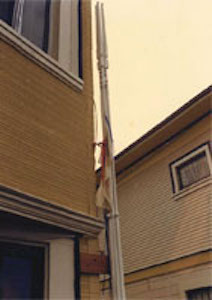
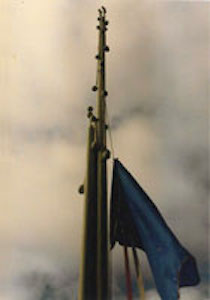
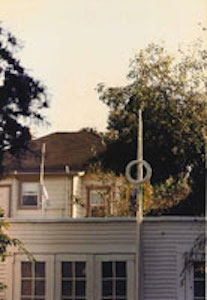
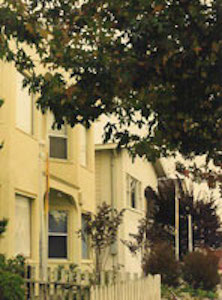
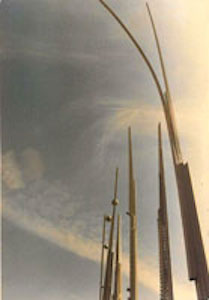
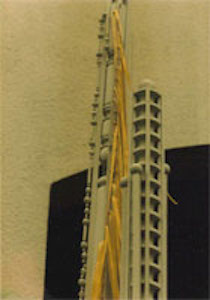
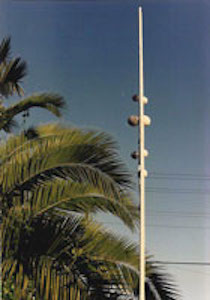


Making Vertical Sculptural Poles

